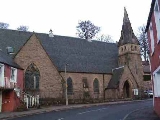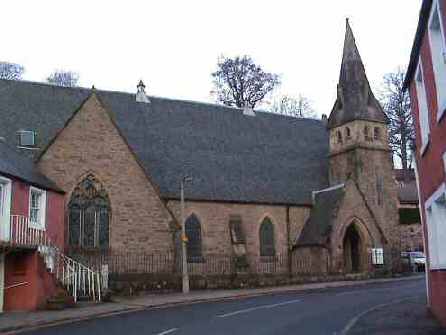
St Blane's Church
Encyclopedia

Church of Scotland
The Church of Scotland, known informally by its Scots language name, the Kirk, is a Presbyterian church, decisively shaped by the Scottish Reformation....
church located in Dunblane
Dunblane
Dunblane is a small cathedral city and former burgh north of Stirling in the Stirling council area of Scotland. The town is situated off the A9 road, on the way north to Perth. Its main landmark is Dunblane Cathedral and the Allan Water runs through the town centre, with the Cathedral and the High...
, Scotland
Scotland
Scotland is a country that is part of the United Kingdom. Occupying the northern third of the island of Great Britain, it shares a border with England to the south and is bounded by the North Sea to the east, the Atlantic Ocean to the north and west, and the North Channel and Irish Sea to the...
. The congregation is within the Church of Scotland's Presbytery of Stirling.
Activities
On a Sunday there is a family service at 10:30am and an evening service and prayer meeting at 6:30pm. During the week the church plays host to a variety of organisations including the Boys Brigade, Girls Brigade and Church of Scotland GuildChurch of Scotland Guild
The Church of Scotland Guild or simply The Guild , is a movement within the Church of Scotland....
. Home bible study
Bible study (Christian)
In Christianity, Bible study is the study of the Bible by ordinary people as a personal religious or spiritual practice. Some denominations may call this devotion or devotional acts; however in other denominations devotion has other meanings...
groups run throughout the year, with Alpha Course
Alpha course
The Alpha course is a course which seeks to explore the basics of the Christian faith, described as "an opportunity to explore the meaning of life" . Alpha courses are currently being run in churches, homes, workplaces, prisons, universities and a wide variety of other locations...
s being run intermittently.
History
The congregation of St. Blane's has its origins in the controversies which bedevilled the Church of Scotland in the 18th and 19th centuries, controversies centring more, perhaps, on the rights of members in the appointment of ministers than on any theological differences.A first congregation of Seceders
Seceders
Amongst other uses, Seceders is a name used for those who followed the 18th century Secession movement from the Church of Scotland, for the history of which see United Presbyterian Church of Scotland....
was formally established in Dunblane 1758 and built its first “meeting house” in what is now the Haining. Initially linked with another congregation in Doune
Doune
Doune is a burgh in the district of Stirling, Scotland, on the River Teith. Doune's postal address places the town in Perthshire, although geographically it lies within the District of Stirling, and administratively Doune is under the control of Stirling Council...
, it grew sufficiently to become a separate entity in 1766. It would have successive name changes, from Associate to First Associate Burgher (that's another story) to United Secession and then United Presbyterian before becoming Leighton United Free Church of Scotland in 1900. Meanwhile, in 1836 the original meeting house was rebuilt on the same site in the Haining. Remarkably, the congregation only had three ministers over these 134 years, Rev. Michael Gilfillan from 1768 to 1816, Rev. James Anderson from 1818 to 1854 and Rev. William Blair from 1856 onwards.
The 18th century secessions in the Church of Scotland had been gradual affairs, both at the national and the local level. Typically a small number of members would secede from the parish church and slowly build up until a viable congregation could be formed, capable of supporting a minister. By contrast the 19th century disruption was an explosive affair in the aftermath of the 1843 General Assembly when, in many instances, the minister and a majority of the parish church congregation broke away to form a new congregation of the Free Church
Free Church
The proper noun Free Church may refer to:Europe-wide:* Evangelical Lutheran Free Churchin Germany:* Evangelical Lutheran Free Church * Independent Evangelical-Lutheran Churchin Iceland:*Reykjavík Free Churchin Norway:...
. In Dunblane the minister of the Parish Church, Rev. William MacKenzie, and eight of the nine elders on the Kirk Session came out to set up such a congregation. By October 1843 a new church, seating 521, had been built and was packed on the opening Sunday. For some reason, however, it was soon found to be unsatisfactory. There is no surviving record of what was wrong, but in 1854 a second church was built across the street from the first one. This would eventually become St. Blane's Church, the old one now being converted into private houses. When the United Presbyterian and Free Churches joined to become the United Free Church of Scotland
United Free Church of Scotland
The United Free Church of Scotland is a Scottish Presbyterian denomination formed in 1900 by the union of the United Presbyterian Church of Scotland and the Free Church of Scotland...
in 1900 the congregation's name became Dunblane East United Free Church.
The union of the Church of Scotland and the United Free Church in 1929 therefore resulted in there being three congregations of the same denomination in Dunblane, the Cathedral, the Leighton and the East. There had been brief talks about uniting the Leighton and East congregations earlier and these were soon revived and continued at intervals with increasing intensity until in 1951, with both congregations simultaneously without a minister, the logic of the case became overwhelming. So in 1952 the two congregations united to form St. Blane's. The East Church became the home of the new congregation. The Leighton Church, after being empty for several years, was turned into a dwelling house and is now part of the Scottish Churches House complex.
Unions of congregations can often be difficult but this was not the case in Dunblane. Within ten years the identity of St. Blane's was firmly established and the housing boom which began in the 1960s led to an influx of members from among the newcomers. The Cathedral and St. Blane's compliment each other, the two buildings being radically different and offering, within the framework of the Presbyterian style of worship, a different ambiance.

